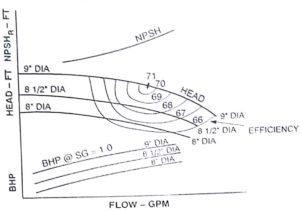The limits of the centrifugal pump curve

A typical centrifugal pump performance curve[/caption]
The centrifugal pump curve has high and low flow limits, which can cause significant mechanical damage to the pump if not avoided. At the low flow end of the curve, flow recirculation can damage a pump, while at the high flow end, excessive NPSHREQUIRED, horsepower and choke flow can result in mechanical damage to impellers, casing, shaft, bearings and seals. Each of these factors is discussed below.
Low flow operation
As we examine these factors we can see that oversizing a centrifugal pump will result in low flows through the impeller. A portion of the flow will reverse itself and set up turbulence as it reenters. The abrupt change I direction and very high acceleration can result in cavitation on the back side of the impeller vane.
Oversizing an impeller can significantly affect performance and mechanical reliability. Pumps are designed to operate at minimum radial thrust loads at their best efficiency point. Low flow operation results in high radial loads, which can cause premature bearing failures unless bearings are selected to accept these higher loads in an anticipation of operation at low flows. Pressure surges and flashing of the liquid can also occur at low flows. This can cause loading and unloading of the mechanical seal faces, which can result in a high temperature rise through the pump, because the amount of energy absorbed by the liquid is low compared to the absorbed by friction losses.
Operation at low flows can result in:
- Internal recirculation damage to impeller
- Operation at less than best efficiency point
- High radial loads
- Bearing failures
- Seal Failures
- High internal temperature rise and requirement for minimum flow bypass
The relationship can also be used to determine the approximate flow rate of any centrifugal pump, by measuring the pipe temperature rise. Referring to the particular pump shop test curve for the calculated efficiency will allow the approximate pump flow rate to be determined. Note: This approach assumes the pump is in new condition. A worn pump will reduce the flow to a greater extent.
High flow operation
Selecting a pump to operate to the far right of the best efficiency point can result in potential problems as listed below.
Operation at high flows can result in
- High to overloading horsepower with reduced system resistance
- Operation in the “break” of head capacity curve (significant changes in head with no change in flows)
- Higher NPSH required than available
- Recirculation cavitation at impeller tips